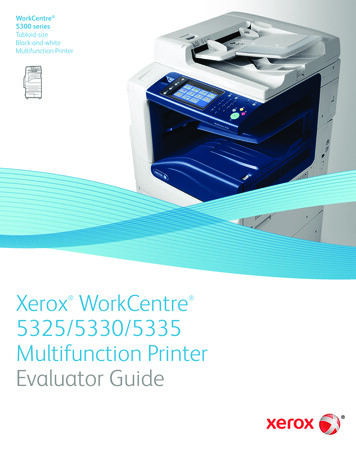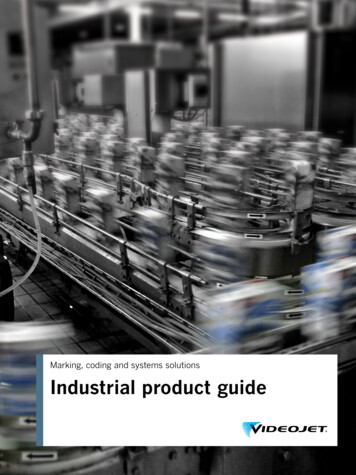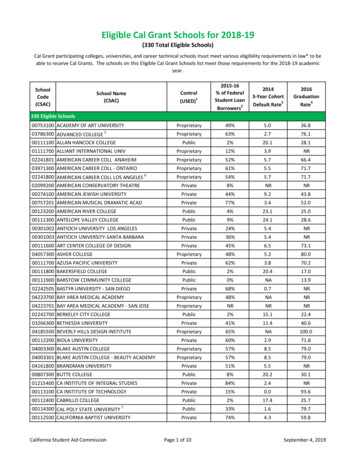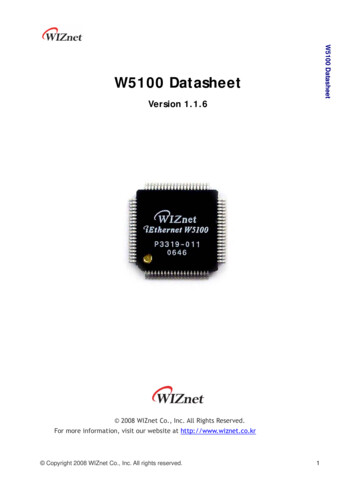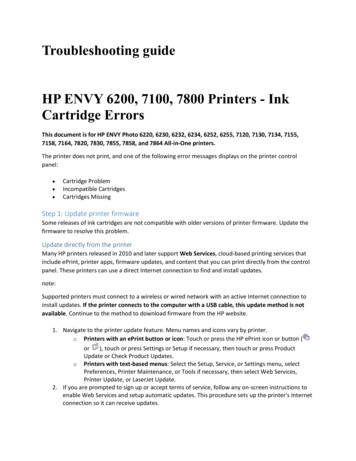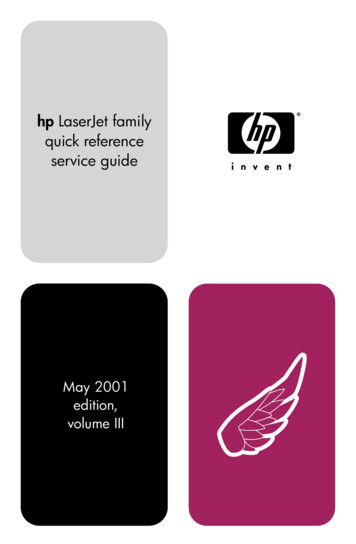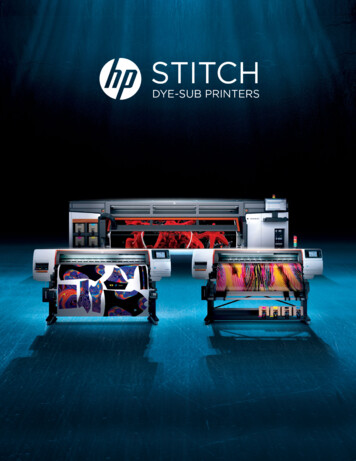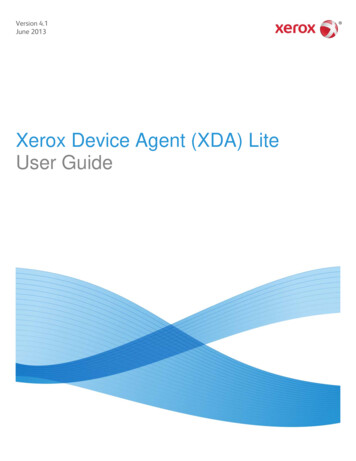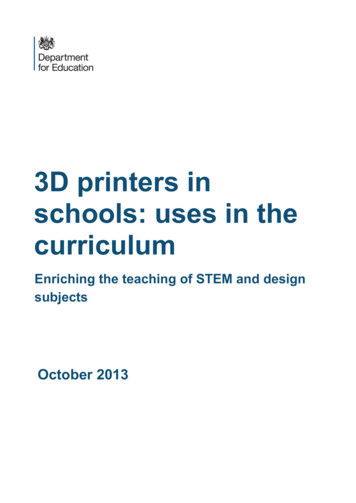
Transcription
3D printers inschools: uses in thecurriculumEnriching the teaching of STEM and designsubjectsOctober 2013
ContentsThe 3D printer project3The role of 3D printers in education4Summary of learning from the 3D printer project5Exploring teaching approaches6The projects7Computing7Design & technology and engineering8Science10Maths12STEM cross curriculum14Factors affecting success16Effects on pupils and learning18Training and development needs19Technical views21Software21Choosing a printer22Other points of feedback from schools:22Conclusions23Acknowledgements232
The 3D printer projectIn 2012-13, the Department for Education (DfE) funded a small 3D printer project toexplore the potential for use of 3D printers to enrich teaching across STEM (science,technology, engineering and mathematics) and design subjects. In particular, schoolswere asked to explore innovative ways of using the technology to help teach morecomplex scientific and mathematical ideas. This report outlines what was learnt from theproject.The twenty-one schools which took part in the project were: Archbishop Holgate's School, York Arden Academy, Solihull Balcarras School, Cheltenham, Gloucestershire Chelmsford County High School for Girls, Essex Court Moor School, Fleet, Hampshire Cramlington Learning Village, Northumberland Dame Alice Owen's School, Potters Bar, Hertfordshire Glyn Technology School, Ewell, Surrey Gosforth Academy, Gosforth, Newcastle-Upon-Tyne Highworth Grammar School for Girls, Ashford, Kent King Edward VI School, Southampton Kirkby Stephen Grammar School, Cumbria Millais School, Horsham, West Sussex Roundwood Park School, Harpenden, Hertfordshire Settlebeck High School, Sedbergh, Cumbria Simon Langton Girls' Grammar School, Canterbury, Kent The Honywood Community Science School, Coggeshall, Essex The Windsor Boys' School, Windsor, Berkshire The King's School, Peterborough Waldegrave School for Girls, Twickenham, Middlesex Watford Grammar School for Boys, Hertfordshire3
The role of 3D printers in education3D printing is now an established industrial technology used for prototyping andmanufacturing products and components across a range of industries. It already hasapplications in many areas of everyday life 1.Figure 1 - 3D printers create solid objects by building up layers of material, guided by modelscreated in computer aided design (CAD) software.Equipping pupils to understand the application and potential of this new type oftechnology will be important to helping prepare them for a world in which similartechnologies will be increasingly commonplace, particularly in STEM contexts.3D printers are gaining popularity internationally across STEM education 2. So far in theUK, the technology has been restricted largely to Design and Technology (DT)classrooms. There is considerable potential, however, for them to be used within a rangeof STEM subjects, for example to enable links to be made between mathematics, designand physics in a similar way to, for example, ‘sound’ enabling links between music,physics (wave properties), biology (hearing) and engineering (concert hall design).1Visit the ITV website for more informationSee fab@school project and the Makerbot 3D project in New York public schools24
The 3D printer project offered an opportunity for schools to explore innovative ways ofteaching STEM subjects, stimulating pupil interest and enriching the curriculum.Summary of learning from the 3D printer projectTwenty-one schools were provided with funding to purchase a 3D printer, consumablesand support. The aim was to investigate the potential of 3D printing to support innovativeand stimulating ways of teaching STEM and design subjects.DT departments tended to form the ‘hub’ of learning through 3D technologies in mostcases. 3D CAD software is already a feature in many DT curricula, so the introduction ofa 3D printer did not require such a steep learning curve compared with otherdepartments.Science and mathematics departments explored the potential of 3D printing within theirsubject area. Many schools reported high levels of pupil motivation when engaged inthese projects.“All the pupils who have been involved with the 3D printer so far have been inspired by itspossibilities. The opportunity to realise a concept or idea quickly into a 3D product is anincredibly powerful teaching tool.”David Jermy - Head of DT, Settlebeck SchoolSchools reported that early work with the printer was often a trial and error process andlimited to demonstrations and printing of small files such as 3D shapes. More effectiveand informed use to deliver the curriculum developed over a period of time. The projecthighlighted the need for good quality upfront training of teachers when introducing newtechnologies including teaching approaches, and sufficient non-contact time to plan themost effective use of the printers. Most schools relied on good technical support bothfrom manufacturers and internal staff to start using the printer effectively.5
Exploring teaching approachesWhere schools chose to engage in cross-curricular work they needed to overcomelogistical challenges and difference in approach to teaching between subjects. The 3Dprinter is ideally suited to project work, where learning arises naturally as part of aninvestigation or construction project. DT teachers were more familiar with this type ofteaching, where pupils spend time on individual project work. In DT it is common forpupils to be given a design brief and be expected to make personal choices about thedesign, which they then test out for themselves.This contrasts with common teaching practice in science and mathematics. Here thefocus is frequently on teaching concepts discretely and in depth. Where physics andmaths teachers engaged with use of the printers successfully, they did so to promotethinking, reasoning and understanding of their subject.The lead engagement of 3D printing in the pilot schools frequently came from DT staff,who organised the printing for mathematics and science teachers. This allowed teachersfrom other STEM areas to see how their subject could make use of the printer. Evenwithin a single subject such as DT, the printer encourages cross-curricular thinking.“. Moves pupils away from the practicality of design (i.e. how to use a saw) and allowsmore opportunity to see how maths and science are an integral part of the process.David Jermy - Head of DT, Settlebeck School6
The projectsComputingHonywood Community Science School designed an advanced 3D developmentlearning tool, enabling pupils to create 3D objects using typed code in POV-Ray 3. Thisenabled pupils to practice writing and debugging code and also supported studyingalgebra and understanding 3D/2D space.Figure 2 - Honywood’s pupil instruction booklet for their collaborative Toy Project. Pupils designed,costed and marketed a plastic toy.A prefect team at the school are now building a mechanical computer using downloadedcomponents.Balcarras School got their computing/ICT pupils designing their own 3D models on theprogram SpaceClaim, moving away from downloaded models. They used theReplicatorG programme to convert .stl files from the CAD software into .s3g format forthe printer. Pupils explored the ideas behind the code used in the conversion. During thenext academic year the department plans to integrate the outcomes of this pilot intoextracurricular lessons and run further curriculum trials. In this way they aim to use the3D printer for more valid experiences rather than superficial, novelty approaches.3www.povray.org7
Design & technology and engineeringFigure 3 - DT departments made good use of the 3D printers, with many examples of GCSE and Alevel projects using the printer.Figure 4 - Year 10 projects at Waldegrave School for Girls produced drawings and products rangingfrom letter stands, business card holders and phone stands for Father’s day’s gifts.8
At Chelmsford County High School for Girls, pupils made brackets and injectionmoulded cases for GCSE Engineering projects, and vacuum formers and model bottlesfor GCSE Graphics.Figure 5 - Following complex A-level projects which would not have been possible without a 3Dprinter, The Windsor Boys’ School experimented with building complete objects and looking atlinking component parts together to incorporate movement.The Windsor Boys’ School pupils also made a desk lamp in model format and werelooking to create a life-size “to-scale” version. This version would then incorporate theunderlying concept of all component parts joining together and working independently.“Older pupils who were familiar with the design cycle (plan, design, make and evaluate)were able to exploit the use of the 3D printer to shorten the “make” phase as the printerwas quicker at producing items. This meant it was possible to spend more time on“design” and “evaluate” to produce a better quality product.”S Griffin-Raphael – Head of DT, The Windsor Boys School9
ScienceFigure 6 - The Kings School, Peterborough bridged expertise in the DT department and thedemands of the physics curriculum. Pupils designed and printed objects for use in scientificexperiments.Some of the prints made by various students across the schools were developed fromscratch rather than from a downloaded template. Products included a multi-coilreplacement for the Westminster Motor Kits, 3D girders to use with strain gauges and aPelton Wheel used as part of an energy turbine. Water-soluble plastics affectmicrowaves, so the effect of shape on lenses can be investigated with printed lenses. Amicrowave lens helped in the teaching of electromagnetic radiation lens design.10
Science departments used the 3D printer as a context to discuss the properties ofplastics, to build models for teaching science such as molecules, eye-balls, cells and sinewaves, and to build components for working equipment such as rockets. The sciencedepartments were less interested in the design process of the models, so printing tendedto involve ready-made designs from downloadable file libraries such as Thingiverse 4.Figure 7 - Arden’s Year 7 project looked at the chemistry of plastic, the physics of the 3D printerand the idea of predators in biology. Pupils created a 'Pokémon' style predator in Google Sketchupand printed these off on the 3D printer.4www.thingiverse.com11
MathsWork in mathematics emphasised developing pupils’ 3D visualisation skills. Printing of 3Dgraphs was not straightforward as they needed to be printed with a supporting mediumwhich is removed after the print. Nonetheless, this was attempted by several schools. 3DPythagoras theorem and trigonometry were also investigated.Figure 8 - At Watford Grammar School for Boys the printer was used to demonstrate a 3D graph forvarious algebraic equations as well as producing examples of regular shapes (Dodecahedron).12
Figure 9 - A Watford Grammar School sixth form group investigated calculus relating to velocity,height and distance of a projectile. A device that had previously been used had become unreliableand a coupling was produced on the 3D printer to hold the internal catapult. A series of projectileswere then produced for the project using the 3D Printer.Figure 10 - The Kings School, Peterborough made a set of cones and part cones for a mathematicsinvestigation into areas and volumes.Figure 11 - At Highworth Grammar School for Girls, a set of laminae were made to support theteaching of centres of mass in mechanics instruction.13
STEM cross curriculumCross curricular STEM learning was offered to a small number of pupils as anextracurricular activity in some schools, generally with an engineering focus, as thisnaturally incorporated skills and knowledge across ‘STEM’.Figure 12 - Plans, printed prototypes and manufactured chairs from engineering lessons at theCramlington Learning Village.In addition to production skills, this involved aspects of the physics curriculum, such aschair stability, forces weighing down during chair occupancy and equilibrium within chairproduction. Pupils also applied mathematics, such as trigonometry involved in calculatingback angles, plotting coordinates in the software so designs would maintain balanceonce printed by the 3D printer, and performing a costing exercise to evaluate value formoney.14
Figure 13 - A printed rocket and launcher from a fortnightly dedicated ‘STEM’ lesson at SimonLangton Girls’ Grammar School. The school plans to incorporate 3D technologies, focussing onproject work which will contribute towards CREST awards. Topics such as robotics, solar andhydrogen powered cars, trebuchets and rockets will make use of a STEM apprentice to supportprinting of 3D files.15
Factors affecting successSchools reported a number of features that they felt contributed to effective use of theirprinters.Experimenting and learningMany of the project teachers reported that it took a few months to become familiarenough with the printer and associated software to use it successfully and confidently inteaching. Integrating use of the 3D printer into the curriculum proved most successfulwith self-confident teachers who were passionate about their subject and not afraid toexperiment and innovate. In contrast, progress was slower where teachers were workingin isolation and did not persist in problem solving or accessing support.It is clear that use of a 3D printer will not instantly change teaching, coursework or lessonplans. Teachers require time and training, and it will take time for schools to integrate thetechnology into the curriculum.CollaborationThe most interesting uses arose when teachers worked collaboratively and where theentire school community was invited to use the printer. Liaison between departmentswas important to ensure that the teaching of the selected software was plannedcollaboratively across the school and across subjects. In two successful schools the leadteacher was both a physicist and a member of the SMT.In several schools technicians played an active role in both facilitating printer use andassisting in the design work. Excellent in-school technician support was an importantfactor in the success of project schools. For example, at Highworth Grammar Schoolfor Girls, the DT teacher and the physics technician worked closely together to design aclass set of equipment which modelled the scattering of alpha particles by gold leaf foil.Figure 14 - Some broader applications of 3D printer technology16
Senior management supportIn the most successful schools senior managers offered practical and financial support aswell as offering their own vision for innovative use of the 3D printer. The positive role ofsenior managers also included encouraging and supporting teachers to use unfamiliartechnology, and building strong teams of talented individuals who could disseminate theirtechnical knowledge to pupils. Trusting these teams through ‘light touch’ managementallowed teachers to focus on the technology and learning aims.In the majority of schools (but not all) the lead teacher was a DT specialist (this is wherethe CAD expertise lies in most schools).AccessibilitySchools reported that accessibility of the machine was a factor in staff and pupilmotivation to make use of it. The majority of printers were kept on view and accessible topupils in DT teaching rooms as the DT staff were typically the major users of the printerand the people with the greatest expertise in its use.The logistics of using the printer were important. In some schools, the printer waspermanently housed in one location; in others it was located in several locations includinga staff room. The location of the printer was based upon school preference and there wasno right or wrong with regards to this.Figure 15 - Future plans of project schools17
Effects on pupils and learningFigure 16 - Schools reported on the motivating effect of the printer on pupils.“With the printer carrying out the ‘production’ of objects, more time can be spentconsidering the science and mathematics involved in design. One pupil stated that the3D printer had heightened her interest in mathematics and improved her desire to learn;subsequently she commented that it improved her level of achievement.”James Brady – Head of Technology, Simon Langton Girls’ Grammar SchoolSome schools reported that pupils with poor concentration were able to see tangibleresults more quickly and as a result they kept interest in the lesson. Several pupilscommented that they could make shapes and components on a 3D printer that theycouldn’t make with the technology they had in class. They were able to explore morecomplex designs and ideas which meant they remained more interested.Figure 17 - Pupils were ‘in awe’ when seeing the printer producing their designs in front of them.18
Training and development needsDuring this project, many of the committed and hardworking teachers and technicianstaking part took a few months to become familiar enough with the printer and itsassociated software to begin to use it with pupils. For this reason, the project wasregarded by many schools as an exploratory pilot. They plan to build on this work,making more informed use of the printers in the next academic year.In a training session provided at the start of the 3D printer project, teachers valued theopportunity to share ideas for using the 3D printers with colleagues. They also benefittedfrom demonstrations of the printer set up and software by experienced presenters. Thetwo schools that were unable to attend this session took longer to get their printers intouse with pupils.Training sessions need to be followed by opportunities to practice what has been learnt.One teacher felt progress would be impossible unless his teaching load was temporarilyreduced. He asked for, and was granted, a period of time off-timetable to consolidate hisprogramming skills.“As part of the bid we brought in training on AutoDesk Inventor and we trained fivemembers of staff from around the school in using this software. The day was veryintense and the training provided the school with open licence software, for the pupilsand staff, which we then provided across the school network.”S Griffin-Raphael – Head of DT, The Windsor Boys School“We had a really good training session. My school and Settlebeck school did a jointcourse which worked out very well.”Kevin Gough – D&T Subject Leader, Kirkby Stephen Grammar SchoolTraining across subject departments is also important: lack of CAD expertise amongstnon DT teachers was reported as a barrier to using the printer to its full potential in theseareas.Schools wishing to introduce 3D printing technologies into teaching of STEM and designsubjects need to factor in time required to train teachers and embed new approaches toteaching. This allows teachers starting from a lower base of expertise in 3D technologiesadequate time to reflect on the various possibilities and to work with other teachers todevelop and implement their ideas.19
Figure 18 - Successful teachers can guide learners in using technologies where the learners maybe more adept than the teacher.To maximise the opportunities that 3D printing offers for subjects beyond DT, particularlyphysics and mathematics, teachers should be open to new ways of teaching, includingpupil-led experimentation. Anxiety about the volume of the curriculum to be ‘covered’may result in more teacher-led approaches in science and mathematics classrooms. Arecent review of research 5 found that independent learning can result in improvedacademic learning and other, wider benefits.There was successful teacher-led training of colleagues and pupils seen within someschools and in other local primary and secondary schools during the project. Wherethese informal networks were set up, other secondary schools were prompted to buytheir own printers.Printers were showcased at Parents’ Evenings and press coverage of one school’sprojects 6 led to several requests for advice locally and globally.56What is independent learning and what are the benefits for students?www.thisiskent.co.uk20
Technical viewsSoftwareObjects to be printed by a 3D printer are created using software design packages. Theoutput, usually a .stl 7 file, is then fed into second piece of software which generatesprinter instructions (G code 8) specific to a particular printer. The G code in .s3g 9 fileformat is then input to the printer via an SD (secure digital) card. In this projectMakerware and Replicator G programmes were generally used to generate the G code.Simple, freely downloadable designs from websites such as Thingiverse were useful asan introduction to how the printer worked. These stimulated ideas for further possibilitiesby staff and pupils during the initial training period.The majority of schools used Sketchup as their software mainly because it is a freeprogram, available for pupils to download out of school hours. In some schools it wastaught at KS3 as part of the ICT curriculum.Dedicated training and on-going support in using the relevant software acrossdepartments proved essential, as it took a while for inexperienced teachers to becomefamiliar with the capabilities of both the printer and the design software. When teacherswere confident, they could teach usage of the technology effectively to pupils.7stl stands for stereolithograph8G-code is a computer programming language which provides instructions for computerised machine toolson what to make and how to make it. G code gives instructions on where to move to, speed of movementand the path of movement.9Sanguino3 G-Code21
Choosing a printerThe project highlighted important considerations for schools in choosing a printer.Points to consider are: Who will use it? What will it be used for? Speed of printing The interface between the printer and the files to be printed e.g. SD card, USBflash drive, files sent via school network Cost of consumables (in the case of ABS and PLA plastics very low) Ease of use Accessibility of printer location Suitability of printer local environment e.g. to minimise draughts and liftingproblems Compatibility of firmware with school operating systems and networks Quality and accessibility of after sales supportOther points of feedback from schools: Some prints can take an hour and a half to complete Pupils have designed models that the machine has been unable to make Number of faults that were diagnosed have been relatively easy to fix The machine requires technical support Open sides on the printer need protecting to avoid draughts, otherwise issuessuch as prints drying prematurely and warping before the printing has beencompleted Some printing materials flow better than others and it was a case of testing theseout to find which was most suitable for the work being undertaken Time and energy is needed if the printer is intended to be more than ademonstration machine – subsequently larger items take many hours to print It is worth persevering with using the machine and overcoming problems Networking Have software in place before engaging with the printersoftware has been an issue22
ConclusionsFeedback from this exploratory project confirms that 3D printers have significant potentialas a teaching resource and can have a positive impact on pupil engagement and learningif schools can master how to use the printers in an effective and meaningful way. Theproject allowed participating schools to explore potential benefits and challenges of usingthis technology in the curriculum and to share their experiences with other schoolswishing to introduce 3D printers.Individual schools decide how to integrate new technologies into the curriculum. Thisreport highlights successes and challenges in effectively implementing 3D printers in theclassroom.Many of the schools involved in this project commented on how motivated their pupilswere by using the printer. Many of the teachers involved were passionate in their desireto successfully embed the printer into their teaching and often devoted much of their owntime to exploring new ways to teach their subjects.If the benefits seen by the participants in this project are to be more widely experienced,schools need to consider challenges faced in introducing the technology, including thoserelating to developing teaching, teacher training and technical support.AcknowledgementsThe DfE wishes to thank the teachers and pupils of the schools involved in this pilotproject for their hard work and commitment during this project and for sharing theirexperiences and results with other schools through this report.Our thanks also go to Joan Ashley, the project manager, and to the Institute of Physicsand National Centre for Excellence in the Teaching of Mathematics for their advice andsupport throughout the project. We would also like to give a special thanks to Angela Hallfor her support in compiling this report.23
Crown copyright 2013You may re-use this document/publication (not including logos) free of charge in anyformat or medium, under the terms of the Open Government Licence v2.0. To view thislicence, visit cence/version/2 oremail: psi@nationalarchives.gsi.gov.uk.Where we have identified any third party copyright information you will need to obtainpermission from the copyright holders concerned.Any enquiries regarding this publication should be sent to usat www.education.gov.uk/contactus.This document is available for download at www.gov.uk/government/publicationsReference: DFE-00219-201324
The 3D printer project offered an opportunity for schools to explore innovative ways of teaching STEM subjects, stimulating pupil interest and enriching the curriculum. Summary of learning from the 3D printer project . Twenty-one schools were provided with funding to purchas
